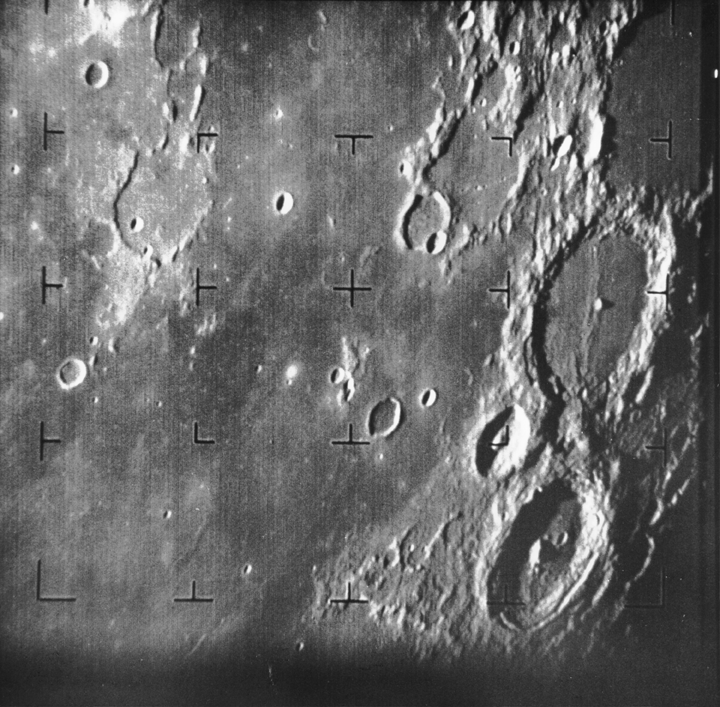by neufer » Mon Jul 06, 2009 2:58 am
http://www.pacifier.com/~tpope/ wrote:
Reproduction of Galileo's Observations of the Moon



<<Left: The Moon at First Quarter, photographed on June 7, 2003 using the positive eyepiece. The large faint crater low on the terminator is
Deslandres. The deeply shadowed crater below it, half way to the Moon's south pole is Maginus.
Center: Engraving of the Moon at First Quarter as it appears in Galileo's book Sidereus Nuncius (1610).
Right: An area slightly below the Moon's center photographed through the negative eyepiece on June 7, 2003. Albategnius is just above the middle of this photo. The three large craters of descending size to its left are Ptolemaeus (top),
Alphonsus and Arzachel.
Deslandres is the large crater at bottom left.>>
-------------------------------------
http://antwrp.gsfc.nasa.gov/apod/ap991015.html wrote:
Explanation: On July 31, 1964, Ranger 7 crashed into the Moon. Seventeen minutes before impact it snapped this picture - the first image of the Moon ever taken by a U.S. spacecraft. Of course Ranger 7 was intended to crash, transmitting close-up pictures of the lunar surface during its final moments. The Ranger program's goal was to begin high resolution mapping of the lunar surface in preparation for a future lunar landing. This first image covered 360 kilometers from top to bottom and is centered in the Mare Nubium (Sea of Clouds).
The large crater at middle right, Alphonsus, is 108 kilometers in diameter.

------------------------------------------------------------------------------
LRO's first image:

<<On June 30, 2009, the Lunar Reconnaissance Orbiter switched on its cameras and began images of the lunar surface. The early images were taken along the terminator line separating the day and night sides of the Moon. This image shows a hilly terrain a few kilometers
east of Hell E crater, south of Mare Nubium.>>
Credit: NASA/Goddard Space Flight Center/Arizona State University
-------------------------------------
http://en.wikipedia.org/wiki/Hell_(crater) wrote:
<<
Hell is a lunar crater that is located in the southern part of the Moon's near side, within the western half of the enormous walled plain
Deslandres. The crater is somewhat circular but with an outward bulge along the western rim. The interior floor is rolling and uneven, with a low but prominent central mound. The sharp-edged rim is not significantly eroded, and has a narrow inner wall.>>
[quote=" http://www.pacifier.com/~tpope/"]
Reproduction of Galileo's Observations of the Moon
[img]http://www.pacifier.com/~tpope/Moon_with_Positive_Eyepiece_450P6070030_small.jpg[/img][img]http://www.pacifier.com/~tpope/Galileo_Engraving_Of_Moon.jpg[/img][img]http://www.pacifier.com/~tpope/Moon_with_Negative_Eyepiece_P6070083_small.jpg[/img]
<<Left: The Moon at First Quarter, photographed on June 7, 2003 using the positive eyepiece. The large faint crater low on the terminator is [b]Deslandres[/b]. The deeply shadowed crater below it, half way to the Moon's south pole is Maginus.
Center: Engraving of the Moon at First Quarter as it appears in Galileo's book Sidereus Nuncius (1610).
Right: An area slightly below the Moon's center photographed through the negative eyepiece on June 7, 2003. Albategnius is just above the middle of this photo. The three large craters of descending size to its left are Ptolemaeus (top), [b]Alphonsus[/b] and Arzachel. [b]Deslandres[/b] is the large crater at bottom left.>>[/quote]
-------------------------------------
[quote=" http://antwrp.gsfc.nasa.gov/apod/ap991015.html"]
Explanation: On July 31, 1964, Ranger 7 crashed into the Moon. Seventeen minutes before impact it snapped this picture - the first image of the Moon ever taken by a U.S. spacecraft. Of course Ranger 7 was intended to crash, transmitting close-up pictures of the lunar surface during its final moments. The Ranger program's goal was to begin high resolution mapping of the lunar surface in preparation for a future lunar landing. This first image covered 360 kilometers from top to bottom and is centered in the Mare Nubium (Sea of Clouds). [b]The large crater at middle right, Alphonsus, is 108 kilometers in diameter[/b]. [/quote]
[img]http://antwrp.gsfc.nasa.gov/apod/image/9910/moon_ranger7_big.gif[/img]
------------------------------------------------------------------------------
[b]LRO's first image:[/b]
[img]http://www.planetary.org/image/lro_first_image.jpg[/img]
<<On June 30, 2009, the Lunar Reconnaissance Orbiter switched on its cameras and began images of the lunar surface. The early images were taken along the terminator line separating the day and night sides of the Moon. This image shows a hilly terrain a few kilometers [b]east of Hell E crater, south of Mare Nubium[/b].>>
Credit: NASA/Goddard Space Flight Center/Arizona State University
-------------------------------------
[quote=" http://en.wikipedia.org/wiki/Hell_(crater)"]
<<[b]Hell[/b] is a lunar crater that is located in the southern part of the Moon's near side, within the western half of the enormous walled plain [b]Deslandres[/b]. The crater is somewhat circular but with an outward bulge along the western rim. The interior floor is rolling and uneven, with a low but prominent central mound. The sharp-edged rim is not significantly eroded, and has a narrow inner wall.>>[/quote]